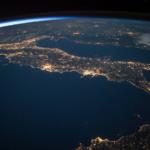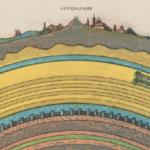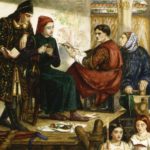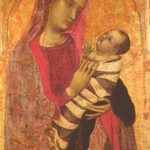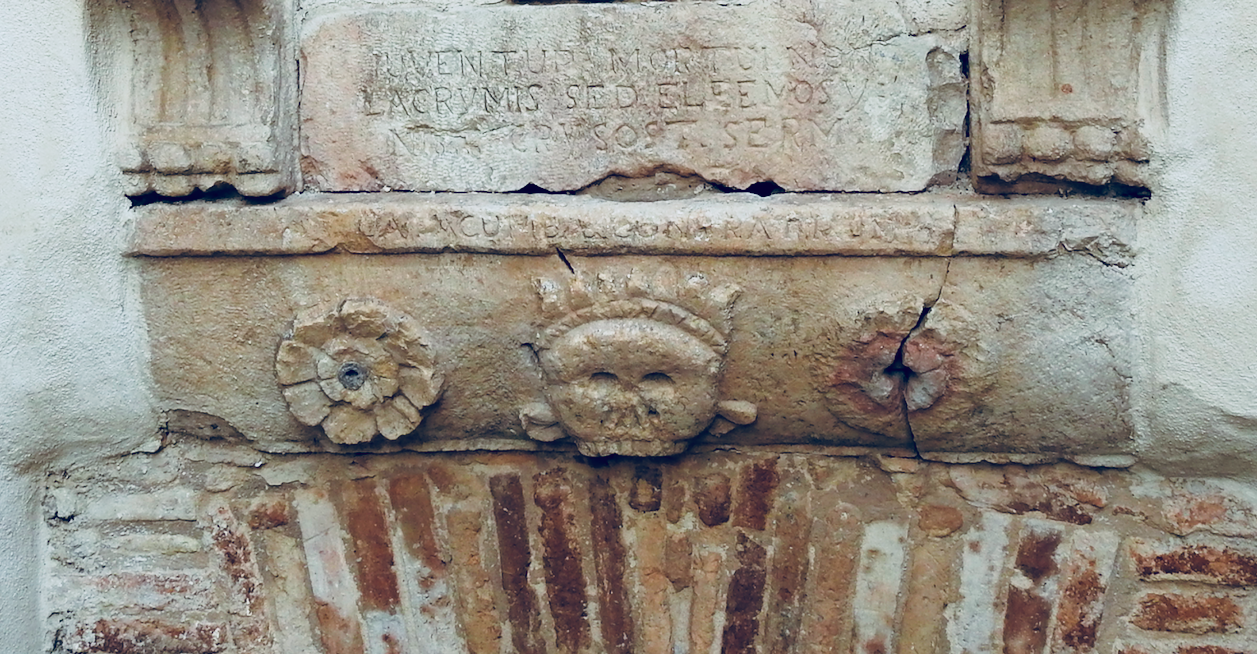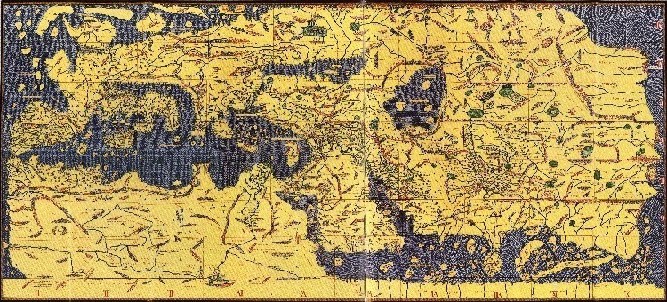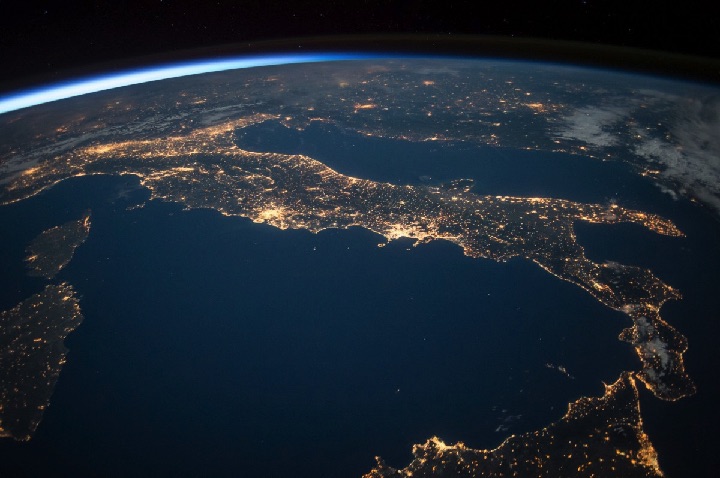
Commentary – Who am I to Speak to You of Italy

This article is the promised commentary on: “Who am I to Speak to You of Italy“, which I wrote in April.
In part a commentary recognises that our words never really leave us. They travel along with us and reveal new unimagined meanings and inspire new departures as they speak to us from memory.
Much is communicated in Who am I to Speak … by allusion; and many unwritten and written words lie under those that were set down, and a commentary may enrich communication. However, it is not necessary to read the commentary and you may choose not to do so, as commentary (even by writer) may also confine meaning more narrowly than the words and indeed the conversation between word and reader demand.
In providing a commentary I have shifted from place of writer to place of reader. Meaning is only partially embedded in the words themselves and arises new-born in each moment in which words come to life in the mind of a new reader. The written symbols are married with all the moments in which the reader has played part before the symbols pass behind the readers eyes.
The technical term hermeneutics, as used by Hans-Georg Gadamer, expresses this process. The process of reading and interpretation in which we discover, understand and in a sense create reality around us. We are readers and interpreters of life.
As reader (who is also here the writer) I recall what the writer meant at the moment of writing, but also see what the writer had not seen when setting down the words. Every new reader will discover things that either the writer or present reader sees or does not see.
Images, like words, may too be read.
Image
Images are read in an instantaneous moment of visual communication; a moment that must capture the intended meaning. Often, image for me must express beauty; for beauty and creation are linked together in the process of writing.
Here an image of Italy is used. However what image to choose? What do we see. Do we see separateness, boundaries and division, or something else? Does our experience inscribe national boundaries, absent in the provided image? The image rather connects Italy within its true matrix of the world: the matrix without which the word “Italy” would have no meaning.
We see the communities of Italy as points of light and see the connections between them. Light and connection emphasises human life and community. Much remains unseen at night and reminds us of how much remains unknown, unrecounted, forgotten in simplified stories. The waters that surround Italy speak of doubt and impermanence; clouds speak of misunderstandings that obscure our vision, storms that roll over us, disturbances in our peace. The sun rises in the East; the hope that ever springs forth anew in human heart. Distance of the vision seen from orbit notes the personal experience of distance from place of origin.
Missing Words:
Much remains unwritten. The need for brevity means that stories are summarised, sometimes only hinted at or entirely untold. The missing words allude to the already written and yet to be written articles and underlying “re-search” that are the sources from which the “first preliminary synthesis” is drawn.
Allusion and Description
Who am I to Speak ... employs many allusions in seeking to convey its meaning. It references the work of other writers and events of history that begin to depict Italy in our minds. Sometimes the allusions are to other Italian Stories I have written.
Although some sources are explicitly identified, in general the flow of the narrative is not interrupted for this purpose. It is an approach in which the joy of reading is enhanced by recognition of what has been previously read or experienced elsewhere, and in which brief allusion evokes layered resonances of meaning. In this approach, as in other points, there is allusion to Dante Alighieri. The approach adopts a custom of Medieval writing, which often did not explicitly reference, in which readers understood that an author only recycles what they have already heard or seen, that nothing is truly or fully original, but merely an extension of conversations that began long before we lived, conversations which we have only lately joined, and will soon leave.
When engaged in creation we walk along a seashore between the ocean of subconscious and the shoreline of the conscious world. Tokens of meaning wash up along that shore in a way which is beyond our conscious understanding. We collect them and perhaps work on them. As we walk along we may find collections that have been left by others who have walked the shore before us. We may draw from those collections. In the end we leave our own collection behind us.
Who am I to Speak … proceeds as a description of “Italy” and her connections, but as a preliminary one drawing on a handful of initial investigations. It is impossible to reductively define something so complex. It is only as we add to our description that we begin to see what Italy might be. The entire work is of course concerned with questions of identity.
Child of the Diaspora
The first paragraph introduces an “I” that is really a “we”. It emphasises that all meaning arises from our interaction with the world and with our fellow human beings; that those around us define us as much as we define ourselves.
The reference to silence in the opening words allude to an individual, yet collective, experience of the Italian diaspora, that are captured by the words of Fred Gardaphé, which appear in the second paragraph. It is an experience that is shared around the world.
The opening words also allude to a concept so much noted of Dante Alighieri. As he opens his Commedia, his opening words begin with the self but emphasise shared human experience: “I” and “we” are the same.
Nel mezzo del cammin di nostra vita
mi ritrovai per una selva oscura
ché la diritta via era smarrita.Midway in the journey of our life
Dante Alighieri, the Divine Comedy, Inferno, Canto 1 (Musa translation)
I came to myself in a dark wood,
for the straight way was lost.
In Dante equating plurality with oneness, we may also reflect that multiplicity and oneness are intimately interconnected; the former but ephemeral projections of the latter.
In our time, the shared “dark wood” may (at a collective level) be taken to represent the dark wood of identity in which humanity is lost and which is the source of such trouble in human affairs.
To begin with the words “Who am I …?” is to place this question of identity centrally before us. It means, without exception, “Who are we …?”
Italian Americans are Invisible People
As we continue to reflect on Fred Gardaphé’s words and thoughts the price of invisibility which he expresses is presented in the metaphor of “coins”. Coins are heavily material. Their expenditure represents the viscerality of loss of identity. It represents a lessening of connection with ourselves and the stories which have made us; which means in the end a loss of connection with those immediately around us. Fred Gardaphé, as does Maria Famà, also reflects on the issue of “whiteness” within the American cultural context. In that context becoming “white”, within the American inventory of the meaning of the term. For her it means abandoning identity and a process of loss.
I am Italian. I am Australian.
Here the rational incoherence of reductive national identity is captured for those whose personal history makes plain that identity cannot fit neatly within the tiny national boxes we make. Although experienced most acutely by those who have “crossed boundaries”, it is true for all human beings who always hold within themselves multiple identifications and innumerable connections that transcend national boundaries or which are strongest in a much smaller spaces still: family, home, community. Human complexity transcends the caricatures into which we render our own beings.
Reflection on such themes was the departure point for the series of Italian Stories I am writing. Here they are also presented as a “significant observation of reality“. This observation arises simply from an accident of vantage point.
Although “subjective”, the observation has been repeated so many times by innumerable observers, that the word “subjective” does it injustice. For it represents a deeper understanding of the ultimate wholeness of human relationships. If it is true for one human being, it is true for all human beings; it just requires climbing to the vantage point to see it. We may compare this vantage point with the vantage point of astronauts, some of whom state that their most important discovery in leaving our planet was its beauty and its oneness as humanity’s shared home.
The words “I am Italian. I am Australian.” also allude to quantum science’s establishment of the inseparable interconnection between subjective and objective worlds. The broader truth of the interconnection between subjective and objective is understood simply if we note that whatever question we may ask, we have already selected the possible answer, we have already confined reality and made it “sing our tune”. Our very ability to even imagine the question comes from our past experience. Subjective is woven into every objectivity.
Normality of nationality is unveiled as culturally constructed. We observe it without judgement or rejection. For its truth, although incomplete, is inseparably part of us. It belongs to us and we belong to it in complex ways.
Italian American Voices Shape Us
This paragraph introduces the truth of our time that the world is in dialogue with America. This dialogue is particularly strong in the anglophone world and, as we shall see has a number of dimensions. For the Italian diaspora in the anglophone world we see that we are shaped by the American conversation. For example, the idea of “the mafia” has become one of the few descriptors the anglophone world attaches to its caricature of Italy – so powerful that barely anything else is ever worth talking about. This issue is explored in the first article of the Italian Stories series.
Italian American voices shape us, also because Italian Americans have themselves participated in the creation of the caricature. “The Godfather” was the work of an Italian American author (Mario Puzo) wrote to cater to the prejudice of the American market. The movies themselves a catalogue of Italian American artistic talent.
Yet in exploring the corpus of Puzo’s works we discover “Lucia Santa” who represents more real accounts of the Italian American experience. She is Puzo’s greatest hero, of whom the Godfather himself is a pale literary and fictional projection. She is invisible (even to most Italian Americans). She stands as symbol of the mountain of meaning that Italian American writers and others have extracted from their experience, yet those explorations rarely enter the public imagination.
In the Shadow of the Statue of Liberty
These words reference a moment of cinematic art found in the second Godfather movie. It is the moment immigrants sail past the Statue of Liberty and arrive in America. As we reflect on this moment, we see that it is profoundly ambiguous and sombre in its presentation. There is no celebration. In the background the music of Nino Rota “immigrant theme” plays. It is a music of loss and the odyssey of a bitter journey. It alludes to the injustice that drove one of the greatest involuntary “voluntary” migrations in history.
It may enter the heart as a song of mourning for the price paid when ocean is crossed. It is a loss that only became apparent to me after visits to Italy as a child and becoming part of a beautiful and loving family who would forever be beyond an ocean. The process of migration is a turn on a path and there is no true going back, for migration forever changes migrant, even as the place of departure recedes as it wends its own independent journey. Time has erased the Italy that was left. Journeys back may be many, but each is to a new and different place.
As Nino Rota’s music ends we experience the glimmers of a new dawn: the new country and hope of a better future lies ahead.
I will not check the box for white
These words introduce the poetry of Maria Famà which was the subject of an earlier article. Her words reference the experience of Italian America which presented Italian Americans with the identity categories which had been defined long before by American history. They are a colour-coded version of humanity so influential in our own time far beyond America’s own shores.
The words “I will not check the box for white” draws attention to the choice facing Italians in America: to acquiesce in a category which ill fits them – and therefore to become invisible and to become less than they were; or to resist the categories. For Maria Famà it is a category incoherent with her truer nature. “I am Sicilian” she writes. She replaces what is less true, with what is more true. It also represents resistance to racial division with which such labels are associated.
The colour coding of American thought is pernicious. The toxic brain child of the worst era of racism, of European colonialism and of American slavery.
The experience of colour-coding is also terribly real and virtually inescapable for Americans who live in a world defined by such categories. Americans are still labelled at birth by categories first generated and little modified since the days of slavery.
It is a particular grove of the dark wood of identity in which America finds itself. The past stories of America are inescapable because they cannot be unwritten. They still beset American life at many levels, as is so much discussed in today’s world. The colour-coding, itself pure fiction, has created a cultural reality. It is a cultural reality which defines community and boundaries of community. It generates particular patterns of human interconnection and disconnection. They frame how two individuals may understand and see each other and themselves. “Racially” oriented communities of America have become culturally real, because patterns of human interaction have created them so. The stories are real. The divisions real. The need for healing real.
However humanity possesses many other stories. Perhaps those other stories may contribute to the healing of America. New arrivals at the American shore have a duty to contribute their stories, for by arriving at the American shore they have shared in the inheritance of their American brothers and sisters: the duty of healing America. Another meaning here is drawn by passing under the shadow of the Statue of Liberty, for oppression has found a comfortable home on both shores of the ocean. Petrarch’s sonnets are hidden in the Statue’s call, and dark and light are reversed.
The incongruity, in the context of Italian experience is expressed by Maria Famà’s poetry, which explores connection across an ocean and identity that reaches towards shared humanity that transcends racism. Her poetry recalls Sicily’s place in an ocean that links Africa and Europe. Sicily, and Italy, look both south and north. It recalls those well known times past when racism was directed against Italians and that Italy also saw its own dark history of racism and colonialism.
The Black Madonna
The Black Madonna of Tindari, a central place of faith for Maria Famà’s people, speaks of the sin of racism. Her evocation as a symbol of racial equality is much deeper than the colour of the wood of which she is made, for the Madonna (of all colours), has always been the mother of those who suffer injustice, as she was the mother of Jesus, who suffered the worst that human beings have done to each other. Millions have turned to her and sought her assistance. She has come to America with her people and remains their guide if they turn to her.
Father, why is she black?
As we follow the story to focus more on the Black Madonna herself, we allude to the broader context of the history of faith and connection with the divine which is part of the story of the people of Italy. We are starting to follow the threads of the Italian story. Characteristic of Italian religious faith is the Madonna, and beyond her the many saints who now form part of Christian faith. The Madonna herself is a feminine symbol of the divine world. She enriches our understanding that the divine world is beyond gender; knowing that all material symbols are but distant and faint echoes of an ultimately inexpressible spiritual reality.
The English airman who found the Black Madonna on the plains of the Tavoliere will be the subject of a future article.
The Women of Castiglione stood by … at the birth of Italy
The words “stood by” evokes the Italian word ostitrice which means “she who stands by”. For many centuries ostitrice was the word used in Italy for midwife. It is ironic that in English the same feminine word, “obstretrix” and “obstetrician” came to refer to a profession dominated by men.
The women of Castiglione literally stand by as ostitrice at the birth of Italy and the birth of the Geneva Conventions. Of course it is not a passive role, but an active intervention so that the newborn may draw its first breath. “Stood by” alludes to the gendered experience of war and the role of womanhood in the generation of life.
Tutti Fratelli. Tutti Fratelli.
This exclamation is taken from the words that Henri Dunant and the women of Castiglione communicated to each other. It is presented here together with the metaphor of the beating heart, the sound of which the repeated phrase evokes. Thus Dunant’s and the women’s hearts speak to each other. It was a deep communication which shifted history. If we could hear the heartbeat of humanity this would be the sound it makes: tutti fratelli, tutti fratelli. “We are all brothers. We are all brothers.”
Although I have not encountered evidence that Dunant or the women of Castiglione were conscious of this, as their purpose was principally their recognition that all were brothers and sisters and that no wounded soldier would be turned away, the words also evoke the national anthem and battle cry of Italy which begins with the words “Fratelli d’Italia“.
They may have heard these words in the mouths of the soldiers marching to the battle. “Brothers of Italy” were words seeking to unify a geography long in political pieces. However, as was the nature of 19th century nationalist thought, they also identified an “other” against whom violence could “rightly” be directed.
The national anthem makes no bones about this, linking concepts of ancient Roman identity with a “Germanic” enemy. In the 19th century this enemy was the Austro-Hungarian empire which at the time occupied much of northern Italy. By the 20th century we would think of such words as “propaganda”. There is nothing particularly unusual about the Italian national anthem. Similar themes may be observed in the founding song of many countries.
Of course such stories are also connected with histories of oppression and passionate belief in the possibility of a better future. Even the belief that Italy might be a better nation than those which came before it: a thought that came to Giuseppe Mazzini.
Henri Dunant viewing the event of the Battle of Solferino as an outsider and spectator saw both the bestiality of war and the nobility of human spirit that it sometimes evokes. He realised that when we see such a wound in the body of humanity our duty is to seek to heal it.
Fault Lines Deep within the Earth
These words introduce the interconnection of Italy (and human life in general) to the physical world: here earthquakes which frequently destroy life and works in Italy. Over and over again the works of human beings have been erased by such physical events and repeatedly human beings have worked to rebuild and heal the loss and harm.
The physical fault lines evoke the political, cultural and theological faultlines which generate man-made disasters which also destroy lives and civilisation. The faultlines which gave birth to Italy reach outwards across Europe, but one epicentre was at Solferino.
As we broaden our perspective the poetry uses the metaphor of “Mare Nostrum“, “Our Sea“, which was the ancient Roman name of the Mediterranean. Once this cultural world was whole, and the children and inheritors of the Roman heritage (both Christian and Muslim) still live side by side around the shores of Mare Nostrum. Yet a cultural and theological divide has opened which centuries has not healed. The line of that divide has shifted back and forth in the centuries, and in the past it ran through Italy itself. However, despite this divide, Mare Nostrum has always also been a zone of interconnection and many times we have seen the evidence of that interconnection; for example in the fields of medicine and the food that today so defines Italy.
Toxic ideologies of race are also at issue. As the idea of “racial purity” has been shown to be dangerous and scientific nonsense, the ideologies of race now seek to entrap us with the idea of “cultural purity”, an equally ill-founded notion. In reality without cultural communication the rich, beautiful and ever moving Italian culture of today would simply not exist.
As we understand the stories that lead to the present, we see how many threads are woven into Italian (or indeed) any culture. We must seek those stories not in histories of “great” men, but in humble places, like kitchen and marketplace.
From Bari shall go forth the law … every uncounted Vico Ebrei that yet adorns Italy
These words draw our attention to a lost past of Italy that was; and a more noble Europe that never was and yet might be. Here the words allude to a yet unwritten article that will explore Jewish history of Italy. Here we find the bitter harvest of theological intolerance; suspicion of difference and lust for the property of neighbour. Here another kind of loss in the hidden stories of the past and forebears who in all likelihood include both persecutor and persecuted.
Until 1540, when it was obliterated by the spread of the Spanish inquisition, Jewish life in southern Italy had been flourishing. In northern and central Italy, it was the holocaust and Italy’s part in it that so devastated Jewish life. Italy has a Jewish community today in many places, though far fewer than in the past.
“Every uncounted Vico Ebrei“: A street sign labelled “Hebrew Lane” is often the only palpable sign we see of Italy’s Jewish past, although found in so many places. Although often humble and dilapidated in appearance, such streets have a spiritual beauty expressing an aspiration not to forget and to honour the past.
They are uncounted because they are of “no account”. In the specific context of my home town, they are uncounted because “Primo”, “Secondo” and “Terzo” etc Vico Ebrei and an entire Jewish quarter (although still known in the oral traditions of the people) were erased when such street names were replaced in the early twentieth century with other names. Although part of the story of Italy, these new names had no specific connection with that quartiere: Via Greci, Vico Saraceni, Via Normanni, Vico Gloria and nearby names of Via Roma, Via Daunia. Here local history was largely erased in favour of a mythologised national history. Uncounted alludes to the invisibility of a hidden, slowly mouldering and neglected synagogue buried in the fabric of that same home town.
“From Bari shall go forth the the law …” This phrase comes from the words of twelfth century French Jewish Talmudic scholar Jacob ben Meir, in a tribute to the flourishing Jewish life of Apulia. The words allude to a most famous verse of the Biblical Book of Isaiah.
For the Law shall go forth from Zion, and the Word of the Lord from Jerusalem. Then He will judge between the nations and arbitrate for many peoples. They will beat their swords into plowshares and their spears into pruning hooks. Nation will no longer take up the sword against nation, nor train anymore for war ...
Isaiah 2:3-4
In the foregoing we see not only a celebration of Jewish life; but also an ancient hope and faith in a better world. It has lived in human hearts since the days when the Babylonians devastated the lands of their neighbours.
The Making of Italy
Here a book is referred to which seeks to find the making of Italy in the brief compass of the few decades which gave birth to modern Italy. “Great men” dominate this story, as they often done in the tellings of history they themselves have ensured is written. When we will come to that story, we will see where it fits in the fabric.
Stairs made for others
“How difficult to climb the stairs made for others” alludes to the words of Dante Alighieri that described his own experience of exile. He uses two phrases to represent his own experience of exile.
The first is “How salty” “the bread of other lands“. This phrase, although representing the subjective experience of the “stranger in a strange land” familiar to many who have found a new home in another place, can be read as the imposition of a value ordering: that homeland is in some sense better than the strange land. This is of course entirely a matter of preference and previous experience – undoubtedly those arriving in Florence would exclaim how insipid the bread of Florence! Dante himself notes this, as has been elsewhere noted.
For this reason I have only used Dante’s second statement, although with slight modification. A closer rendering is his actual words is “how difficult the path to climb and descend the stairs of other”. This has been represented as “stairs designed for others” emphasising that it is simply a question of displacement, and not inherent in the stairs themselves. In Dante’s case the words also carry a resonance of the “beggar” who is beholden at a stranger’s door and does not have a home of their own, as was part of his life story.
Beatrice stands before me
This paragraph introduces, again by allusion to Dante, the potential trajectory of works yet to be written. Beatrice is material, as is a geographic place such as Italy. Yet in Dante’s mind, Beatrice transcends her material form and indeed her mortality. Here this concept is adopted to hint at the potentiality of transcendence of material aspects of “the nation”. It is a journey of love, yet the journey takes us far beyond our initial imaginings. Beatrice also stands in Dante’s telling for assistance that comes from another place, without which we cannot find the way.
Who am I to speak to you of Italy?
As we end we return to the personal and individual. Here we express the limitations of the human condition. That all we may undertake is ultimately a gift of realms beyond us. That any journey we may undertake may not be completed, that we may be become lost, or not complete the journey.
The circularity of evoking the opening words also alludes to ancient and medieval conceptions of time and journey, in which time was not necessarily linear but returns to the beginning. It may be taken to represent the journey of the soul through the material realm as it seeks to return to the divine world that was the source of its origin. Yet it is only the process of journey through material life (as Dante’s journey implies) that allows us to return to the beginning.
Commentary as Literary Device
Even the use of commentary as a device contains an allusion and connects with additional meanings. It is a tribute to Dante’s Vita Nuova, where he uses precisely this device of speaking to us about his own poetry. Perhaps (as scholars have commented) in doing so, he imbues his poetry with new meaning that was not there when it was first written.
Dante’s prominence in this work also connects to the present moment of writing, which occurs at a time when I am particularly reflecting on Dante’s work. It connects to moments in 2019 in a particular place where Italian literature is experienced as a specific collection at a national capital: that held by the Australian National University library. Much of the library’s collection of history (including Italian history) was lost in the flood of 2018 which flooded the lower ground floor of the library. This event also shifted my investigations. For it forced a shift of focus to Italian literature.
Italian literature survived the “great flood” because it is found on a higher floor of the library. Literature is first person history, for even when unintended, long dead writer takes us back through time and allow us to share their journey as we read their words.
Here we see how between writer and reader words, across hundreds of years and thousands of miles, travel faster than light through the dimension of thought, a dimension not yet accounted for in our models of space and time.
